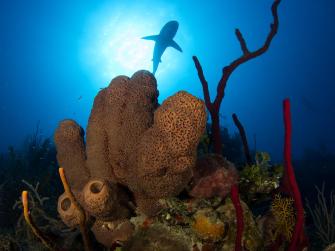Marine protected areas in Cuba
Keys to ecosystem health and sustainable fishing

Named for Queen Isabella of Spain 500 years ago by Christopher Columbus, the Gardens of the Queen (Jardines de la Reina) archipelago is a string of hundreds of mangrove-fringed islets and cays stretching over 150 kilometers along Cuba's southeastern coast. Still nearly devoid of human footprints today, the area is "a window into the Caribbean as it looked in Columbus' time," says Valerie Miller, director of EDF's Cuba program.
In the 1990s, the Cuban government set aside the Gardens as an 850-square-mile marine reserve — one of the biggest in the Caribbean, equivalent to 411,400 football fields — as part of an eventual island-wide network designed with help from EDF in the early 2000s. With commercial fishing and other activities restricted, the area, which was designated a national park in 2010, provides a baseline for gauging the health of sea life and habitats in adjacent areas where such activities are not curtailed. Its protection has international importance by providing connectivity between marine ecosystems across the Caribbean region.
This highly productive and biodiverse area contains some of the most pristine coral reefs left in the Caribbean and remains a haven for fish and other sea life. The reserve has large populations of sea turtles, including hawksbill and green, an abundance of sharks, huge groupers and thick seagrass meadows — all indicating a healthy and interconnected ecosystem. The park is also a world-famous destination for scuba diving, bird watching and fly-fishing, making it an important economic engine for the area.
Cuba's beauty is not accidental
Cuba's network of more than 250 natural reserves on both land and sea, representing 20% of its territory, is not a coincidence. Over several decades, Cuban authorities have developed a range of policies and programs that demonstrate a long-term commitment to conserving the island's resources for the benefit of Cuban people.
This pledge is embodied through the National System of Protected Areas of Cuba, or SNAP. EDF has worked with SNAP to strengthen the design and management of marine reserves. EDF supported SNAP and others in establishing two new marine reserves through a community-based project called SOS Pesca. This project brought together park rangers, scientists, fishermen and community members to collect baseline data and develop management plans for Ojo de Agua and Macurije-Santa María Wildlife Refuges. The purpose of these reserves was clear for everyone, and as one fisherman stated, "The marine protected area is like a fish nursery and the regulations are like the laws that protect children. The fish are born, grow and reproduce there and it benefits all of us."
These efforts conserve critical marine habitats that have played an important role in fostering environmental cooperation between Cuba, the U.S. and other countries within the Caribbean region. The "Sister Sanctuaries Agreement" and the "Environmental Accord" are some of the most recent examples of important progress toward greater U.S.-Cuba collaboration.
Fishermen help protect resources
Marine reserves supported by fishermen are key elements of Cuba’s vision for marine and coastal sustainability. Our work aims to integrate sustainable fishing strategies with marine reserves, supporting the goals of management agencies and working together with communities to protect critical habitats and reap the benefits.
However, illegal fishing and conflicts with access to resources are major threats to protected areas throughout the Caribbean. In the Gardens of the Queen and other marine reserves, enforcement and compliance are important issues. For many countries, including Cuba, patrol boats are prohibitively expensive. But, with the right incentives, fishermen can help conserve the resource and enforce the rules while improving their livelihoods at the same time.
Through the SOS Pesca project, EDF promoted a dialogue between fishing communities and government officials to help bridge this gap. This project involved the fishing communities of Playa Florida and Guayabal along the southeastern shelf of the island, an area teeming with marine life and responsible for about 40% of fish production for the entire country.
Building upon the success of SOS Pesca, the recently created Sustainable Fisheries Learning Network provides a platform for managers, scientists, fishermen and other stakeholders to work together to develop and implement science-based fisheries and marine area management.
Resources
MEDIA CONTACT
Reggie Paros
(202) 572-3390 (office)













